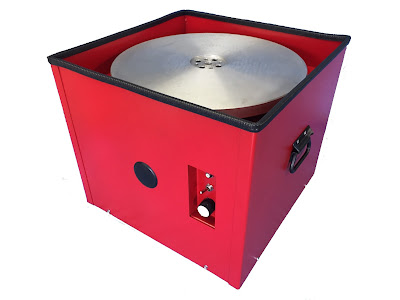An Introduction to the CS-201-2017 Low AMP Machine
Why Update?
For over 16 years the CS-101-2000 Clipper BladeSharpening Machine had arguably been one of the best on the market but a lot
can change within an industry in that amount of time. When Jason, owner of The
Edge Pro, acquired the Nebraska Blades company in February of 2016 he knew it
was time to make some needed modifications and upgrades to the Classic CS-101-2000
Machine.
Jason, having been a distributor for Nebraska Blades for
many years prior to becoming the new owner was completely aware of the
CS-101-2000’s success and shortcomings. Jason had spoken with many customers
over the years about how the machine was not ideal for mobile units but it
could work with a little effort.
Back in 2014 Jason had also acquired Huff’s Wholesale and
the rights to the Extreme Kut Clipper Blade Sharpening Machine. While that
machine never saw the market again due to complications with the manufacturing
process, Jason knew that it had some valuable design features he wanted to
combine with the CS-101.
Immediately following the acquisition of Nebraska Blades
Jason started drawing up plans for a new and improved clipper blade sharpening
machine that would enable customers to thrive in their shops and in their
mobile units.
What’s New?
The first and most imposing step was to eliminate that
pesky 34 AMP draw on startup! After quite a bit of research Jason discovered he
could do away with the current motor and replace it with a more powerful three
phase motor and a WEG VFD controller. Switching motors and adding a VFD gave the
machine some handy new features, one of them being a motor brake to replace the
old hand brake.
Secondly, the new machine has a variable speed control
knob allowing you to sharpen from a max of 1750 RPMs down to 50% speed (around 875 RPMs
but not exactly). Thirdly, upon request, the new machine can be reversed
optimizing the machine for those sharpeners who are left handed. Fourth, but
not least, the initial startup AMP draw of 34 has be dropped to somewhere
between 3 to 6 AMPs!
Upon much contemplation, the decision was made to modify
the housing cabinet of the machine. The first modification to note was to bring
the outside edge of the cabinet up a little bit higher to cut down on the
amount of grit the wheel throws at the sharpener. This keeps everyone and the
sharpening space a little cleaner. Next, Jason evaluated that sometimes-annoying
toggle switch that sticks out and decided to make all the switches and knobs
recessed into the side of the machine.
What About My
Old Machine?
Jason knew when the machine was released we would have customers who
will want to upgrade their Classic CS-101-2000 Clipper Blade Sharpening Machines
to include the technology and features of the New CS-201-2017 machine. We have
made a conversion kit available as an affordable alternative to buying a whole
new machine.
For only $1300 the kit includes the new motor, the VFD power inverter,
the recessed switch housing and switches, mounting brackets, layout templates
and instructions.
While all of this may sound complicated, we have worked very hard to
make this a simple conversion for our customers and as painless as possible.
While we tried to keep the process simple, there is some effort and assembly
required but we will be your resource through the process.
What’s The
Damage?
The upgrades from the CS-101-2000 to the new CS-210-2017 are extremely
valuable to any sharpener. Unfortunately, the added hardware to the machine
pushed the price up slightly. Having said that it is worth noting that the
price on the Classic CS-101-2000, prior to 2017, had stayed the same since 2000
(if you are curious what that should cost with 17 years of inflation it would
be around $2200).
Jason wanted to keep the CS-201-2017 Low AMP machine as affordable as
possible but the price could not stay the same. The new CS-201 Low AMP Clipper
Blade Sharpening Machine will start at $1995 with a 14” diameter rolled
aluminum plate and $2195 with a 16” diameter cast aluminum plate.
What If I’m Happy
With The Old One?
The plan is to continue selling the Classic CS-101-2000
as the perfect beginner machine. It is called a “101” because it is an entry
level machine and is bare bones and user friendly. The new Low AMP machine is
called a “201” because there is a little more to it than the classic machine.
The CS-101-2000 will be available online and in our
catalogs for those customers who are content with it and in fact, the updated
cabinet features will even start showing up on it as well.
It is important to note that in 17 years the world has
changed and inflation has caused even fast food restaurants to remove beloved
dollar menus. We still want the CS-101-2000 to be affordable for those starting
out in the industry or simply looking to have a backup but there was no getting
around the fact that pricing needed to be adjusted. The Classic CS-101-2000 Clipper Blade
Sharpening Machine will start at $1695 with a 14” diameter rolled aluminum
plate and $1895 with a 16” diameter cast aluminum plate. This new pricing will
go in to effect as of April 1, 2017.
What Now?
The New CS-201 Low AMP Machine became available as of March
1, and we are happy to answer any questions you may have.
New Nebraska Blades catalogs are also now available via
email upon request or snail mail for a small postage fee.
Keep us in mind. We want to continue to be a resource for
your company and to see it continue to grow and be successful in the industry.
Nebraska Blades
The Edge Pro
1163 SW Ordnance
RD
Ankeny, IA 50023
Phone:
866-963-1990
Fax: 515-964-0616
NebraskaBlades.com







